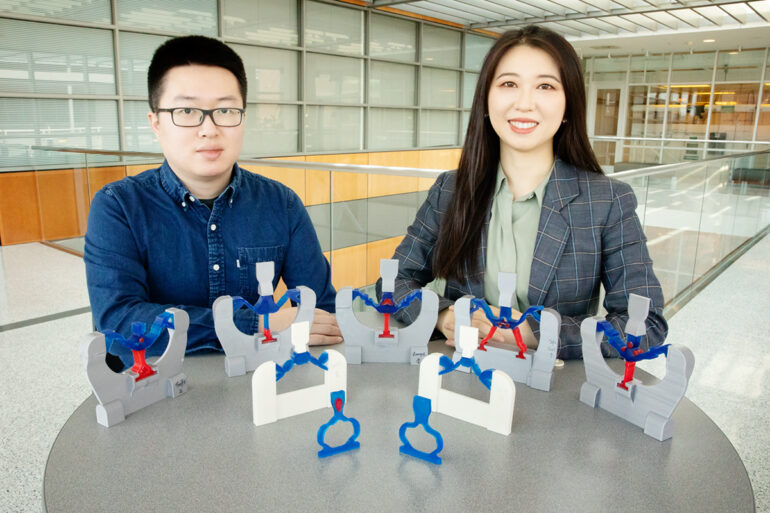A new study challenges the conventional approach to designing soft robotics and a class of materials called metamaterials by utilizing the power of computer algorithms. Researchers from the University of Illinois Urbana-Champaign and Technical University of Denmark can now build multimaterial structures without dependence on human intuition or trial-and-error to produce highly efficient actuators and energy absorbers that mimic designs found in nature.
The study, led by Illinois civil and environmental engineering professor Shelly Zhang, uses optimization theory and an algorithm-based design process called topology optimization. Also known as digital synthesis, the design process builds composite structures that can precisely achieve complex prescribed mechanical responses.
The study results are published in the Proceedings of the National Academy of Sciences.
“The complex mechanical responses called for in soft robotics and metamaterials require the use of multiple materials—but building these types of structures can be a challenge,” Zhang said. “There are so many materials to choose from, and determining the optimal combination of materials to fit a specific function presents an overwhelming amount of data for a researcher to process.”
Zhang’s team set its sights on designing macroscale structures with the prescribed properties of swift stiffening, large-scale deformation buckling, multiphase stability and long-lasting force plateaus.
The new digital synthesis process generated structures with optimal geometric characteristics composed of the optimal materials for the prescribed functions.
Researchers ended up with model devices made from two different polydimethylsiloxane, or PDMS, elastomers with a basic geometry that looks remarkably like the legs of a frog—or a family of three frogs, each with different geometries that use the two PDMS elastomers in various arrangements that function very much like biological muscle and bone.
“It is quite remarkable that what we found is very much aligned with what biology and evolution create naturally,” Zhang said. “For example, when we asked the algorithm to develop a device with swifter stiffening responses, it would respond with larger ‘muscles’ on our mechanical frogs, just as it might happen in nature.”
Zhang said the work’s overarching strengths are found in its sustainability characteristics.
“We have designed reusable and fully recoverable energy dissipators, which is aligned with today’s demand for sustainable devices that are good for the environment. These are not single-use devices. We designed them using purely elastic materials, allowing us to reuse them many times,” she said.
The researchers said their digital synthesis technique will increase the range of programmable metamaterials that can handle complex, previously impossible mechanical responses, particularly in the areas of soft robotics and biomedical devices.
Zhang also is affiliated with mechanical science and engineering at Illinois.
More information:
Digital synthesis of free-form multimaterial structures for realization of arbitrary programmed mechanical responses, Proceedings of the National Academy of Sciences (2022). DOI: 10.1073/pnas.2120563119
Provided by
University of Illinois at Urbana-Champaign
Citation:
New approach to flexible robotics and metamaterials design mimics nature, encourages sustainability (2022, February 28)



